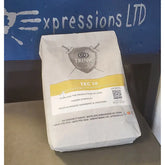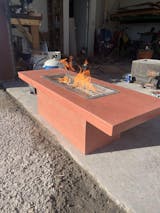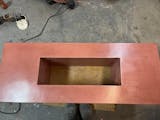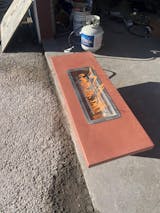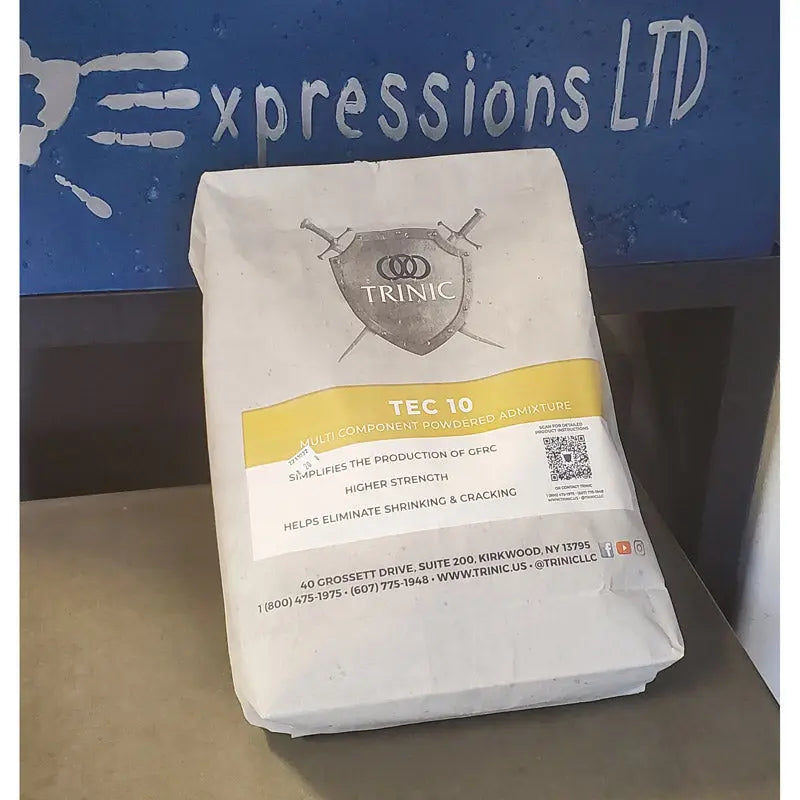
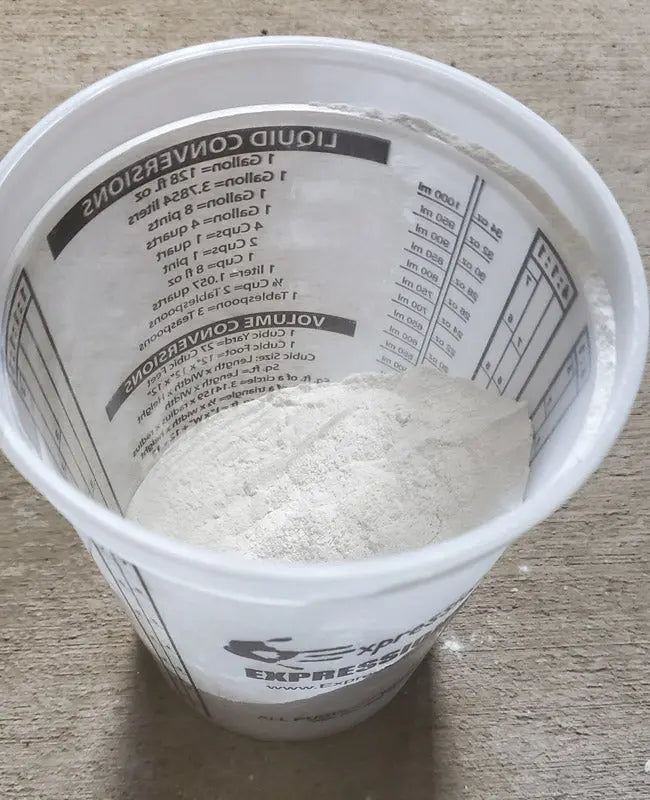
Trinic TEC 10 Powder Polymer Admix for GFRC and Concrete
Size
Ships from Oregon (Click for average Ground delivery map
 )
)
Trinic TEC 10 Powder Polymer Admix for GFRC and Concrete
Replace your liquid polymer with Trinic Tec10 Admix- a multi- component dry powdered admixture for production of ultra-high performance GFRC, RPC, and ECC Concrete. Takes the hassle out of making ultra-high performance Glass Fiber Reinforced Concrete, Reactive Powder Concrete, and Engineered Cementitious Composite Concrete. Easy to understand dosage simplifies what can become an overly complicated process.
Each bag contains a desiccant packet to keep the product dry. DO NOT USE (or eat)
- No more mixing and matching several different admixtures at different dosage rates to produce high performance concrete.
- Eliminates foaming and moldy product problems associated with liquid polymers.
- Improves color dispersion, intensity, and stability.
- Contains specialized additives for water reduction without effecting spray up applications. Helps eliminate surface crazing, bowing, and curling.
- Helps eliminate pinholes, leading to a denser, more acid and stain-resistant concrete
Specifications Trinic TEC 10
- Standard product is the 20lb Bag. We also sell a small 1.5lb (quart) size container for small projects/testing purposes. And large quantity available by the pallet and supersack with Free Shipping via Freight to the US 48!
- Available in 1.5lb Quart Container, 20lb Sack, and Pallet Quantities (pallets ship from New York)
- Coverage: 20 lbs. at 3% dosage will make up to 160 sq. ft. at 3/4" thick.
- Coverage: 1.5lb Container at 3% dosage will make up to 12 sq. ft. at 3/4" thick.
- Download: Tech Data Sheet
- Download: Safety Data Sheet
Dosing / Mixing Instructions Trinic TEC 10
Dose Trinic Tec 10 admix at 3% of the cementitious weight. If needed the dosage can be increased up to 4% of the cementitious weight. May be used in a traditional wetcast mixes at 2% of the cementitious content.
MIX DESIGN: Trinic has developed easy to use formulas to assist you in developing several high and ultra high performance mix designs:
-
BASIC GFRC MIX (@ 1/2 Cubic Foot Yield)
This is enough to produce 8 square feet of GFRC ¾” thick.
Back coat is just face coat with glass fiber dosed in the range of 2-4% of the total dry weight of the batch
- Portland Cement 30 lbs
- We recommend White Portland cement. Different cements will react slightly differently to the admixture.
- You can replace part of your Portland cement with a pozzolan to make stronger and greener GFRC. We recommend Bright White Silica Fume.
- Always make a test batch prior to production runs
- Sand 30 lbs
- Sand graded anywhere from 30 grit (fairly course) to 70 grit (very fine) can be used
- Recommend starting with a 40-50 grit sand for face coats and back coats.
- You can offset thirsty fine sand with additional Trinic Plasticizer.
- Water - 9 lbs or 1.08 gal
- This will give you a water to cement ratio of .3, which is a very good starting point
- You can add up to an additional 1% of the cementitious weight of Trinic Plasticiser to make a Self-Consolidating GFRC Mix. Start at .25% Plasticiser and work your way up from there as required.
- Trinic Tec 10 Admix
- Dose at 3% of the cementitous weight. Ex. 30 Lbs. (cementitous content) x 3% = 0.9 lbs Trinic Tec 10 admix.
- Water Demand
- Cement Type - Different cement types will have different water demands to reach the same slump. Not just white and grey, but cement from different mills will react differently.
- Sand - The size of the sand grain and the sand type both have an effect on slump. Generally the finer the sand the higher the water demand.
- The water to cement ratio is the total water divided by the total cementitious content.
- The water in the sand or the absorption factor of the sand must be accounted for in order to calculate an accurate water to cement ratio.
- Extremely wet sand can contain up to 10% moisture.
- Dry sand can absorb up to about 2% of its weight in water. This is known as satisfying the sand’s absorption factor.
- The sand absorption is largely responsible for the false set you may experience.
- DRY SAND EXAMPLE:
- Example with dry sand. 30 lbs of sand and 30 lbs of cement... How much water gives you a .3 w/c ratio?
- 30 lbs of cement * .3 = 9 lbs of water
- 30 lbs sand with an absorption factor of 1.5 = .45 of additional water to satisfy the sand’s absorption
- Adjusted water to achieve a .3 w/c ratio is 9.45 lbs
-
FAST SETTING GFRC MIX DESIGN
- Sand 30 lbs
- Portland 25 lbs
- CSA Cement 5 lbs: This can vary depending on required set times (this is 20% of portland dosage)
- Tec 10 Admix 0.9 lbs. This is a 3% dosage based off cementitous total (3% x 30 lbs = 0.9 lbs)
- Water: Start off with a .30 water / cementitous ratio (9 lbs water, add about 80% mix, then add as needed)
- Plasticizer: Add plasticizer at up to 1% dosage for doing SCC
- Fiber: Add fiber in backer coats or all in one SCC pours at 3% total dry weight (60 lbs x 3% = 1.8 lbs fiber)


